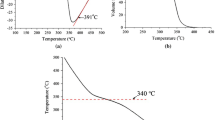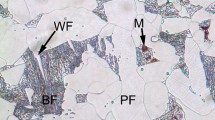Abstract
Industry standards require postweld heat treatment (PWHT) to reduce the heat-affected zone hardness of steels such as F22 (2.25Cr-1Mo) and AISI 8630 overlaid (clad) with Alloy 625 weld metal. PWHT results in carbon diffusion and accumulation at the interface between the steel and overlay. The accumulation of carbon in a planar solidification growth zone adjacent to the fusion boundary results in high hardness and the potential for hydrogen-assisted cracking. The planar growth zone (PGZ) is so narrow that normal Vickers hardness testing cannot fully reveal the hardness distribution in this zone. This study focused on the application of nanoindentation to characterize the hardness in the narrow microstructural regions adjacent to the fusion boundary. The development of nanohardness maps revealed that the PGZ is not necessarily the region that exhibits peak hardness after PWHT. The highest hardness values were associated with clusters of M7C3 carbides in specific subregions in the PGZ and also in the partially-mixed zone adjacent to the fusion boundary or in steel “swirl” structures. It was also confirmed in this study that nanohardness has a linear correlation with Vickers hardness values. The results presented here provide new insight into the role of carbon diffusion during PWHT and its effect on interface embrittlement associated with Alloy 625 overlays on steel.








Similar content being viewed by others
References
NACE MR0175/ISO 15156-2: 2009, Petroleum and Natural Gas Industries-Materials for Use in H2S-Containing Environments in Oil and Gas Production-Part 2: Cracking-Resistant Carbon and Low Alloy Steels and the Use of Cast Iron. in International Standard, NACE International/ISO2001, 2003, pp. 17–44.
B.T. Alexandrov, J.C. Lippold, J.W. Sowards, A.T. Hope, and D.R. Saltzmann, Fusion Boundary Microstructure Evolution Associated with Embrittlement of Ni-Base Alloy Overlays Applied to Carbon Steel, Weld. World, 2013, 57, p 39–53
T. Dai and J.C. Lippold, Tempering Behavior of Fusion Boundary Region of Alloy 625 Weld Overlay on 2.25Cr-1Mo Steel, Weld. J., 2017, 96, p 467s–480s
T. Dai and J.C. Lippold, Tempering Behavior of the Fusion Boundary Region of Alloy 625 Weld Overlay on 8630 Steel, Weld. World, 2018, 62, p 535–550
W.C. Oliver and G.M. Pharr, An Improved Technique for Determining Hardness and Elastic Modulus Using Load and Displacement Sensing Indentation Experiments, J. Mater. Res., 1992, 7(6), p 1564–1583
W.C. Oliver and G.M. Pharr, Measurement of Hardness and Elastic Modulus by Instrumented Indentation: Advances in Understanding and Refinements to Methodology, J. Mater. Res. (JMR), 2004, 19, p 3–20
W. Zhu, J.J. Hughes, N. Bicanic, and C.J. Pearce, Nanoindentation Mapping of Mechanical Properties of Cement Paste and Natural Rocks, Mater. Charact., 2007, 58, p 1189–1198
P. Maier, A. Richter, R.G. Faulkner, and R. Ries, Application of Nanoindentation Technique for Structural Characterisation of Weld Materials, Mater. Charact., 2002, 48, p 329–339
M.F. Dodge, The Effect of Heat Treatment on the Embrittlement of Dissimilar Welded Joints—Dissertation, University of Leicester, Leicester, UK, 2014
J. Hollomon and L. Jaffe, Time-Temperature Relations in Tempering Steel, Met. Technol., 1945, 12, p 223–249
D.A. Lucca, K. Herrmann, and M.J. Klopfstein, Nanoindentation: Measuring Methods and Applications, CIRP Ann. Manuf. Technol., 2010, 59, p 803–819
A.C. Fischer-Cripps, Nanoindentation, 3rd ed., Springer, New York, 2011
X. Shi, H. Yang, G. Shao, X. Duan, and Z. Xiong, Nanoindentation Study of Ultrafine WC–10Co Cemented Carbide, Mater. Charact., 2008, 59, p 374–379
P. Mencin, C.J. Van Tyne, and B.S. Levy, A Method for Measuring the Hardness and Elastic Modulus of the Surface Layer on Hot Forging Dies Using a Nano Indentation, J. Mater. Eng. Perform., 2009, 18(8), p 1067–1072
Rice, P.M., and Stoller, R.E., Correlation of Nanoindentation and Conventional Mechanical Property, in MRS Online Proceeding Library Archive, 2000, p. 649.
Sawa, T., Correlation between Nanoindentation Test Result and Vickers Hardness, in IMEKO 2010 TC3, TC5 and TC22 Conferences, Pattaya, Chonburi, Thailand, 2010.
Zhang, L., Ohmura, T., and Tsuzaki, K., Application of Nanoindentation Technique in Martensitic Structures, in Nanoindentation in Materials Science, InTech, 2012, pp. 109–130.
D. Bourgeois, Hydrogen Assisted Crack in Dissimilar Metal Welds for Subsea Service under Cathodic Protection: Dissertation, The Ohio State University, Columbus, 2015
H.J. Kim and D.E. Kim, Effects of Proximity on Hardness and Elastic Modulus Measurements of SiO2 and Cu by Nanoindentation, Tribol. Lett., 2013, 49, p 85–94
J.A. Fenske, Microstructure and Hydrogen Induced Failure Mechanisms in Iron-Nickel Weldments, University of Illinois at Urbana-Champaign, Urbana, IL, 2010
T. Dai and J.C. Lippold, The Effect of Postweld Heat Treatment on Hydrogen Assisted Cracking of F22/Alloy 625 Overlays, Weld. J., 2018, 97, p 75s–90s
Dai, T. and Lippold, J.C., The Effect of Postweld Heat Treatment on Hydrogen-Assisted Cracking of 8630/Alloy 625 Overlay, Weld. World, 2018, 62, p 581–599
Acknowledgments
This work was supported by Schlumberger (originally Cameron International) through the NSF I/UCRC Manufacturing and Materials Joining Innovation Center (Ma2JIC) at the Ohio State University. Cameron International provided the base materials, and Acute Technological Services provided the filler metal Alloy 625 and produced the overlay weld samples. The assistance of Andres Acuna for providing instruction on use of nanoindentation equipment is also appreciated.
Author information
Authors and Affiliations
Corresponding author
Rights and permissions
About this article
Cite this article
Dai, T., Lippold, J. Characterization of the Interface of an Alloy 625 Overlay on Steels Using Nanoindentation. J. of Materi Eng and Perform 27, 3411–3418 (2018). https://doi.org/10.1007/s11665-018-3444-1
Received:
Revised:
Published:
Issue Date:
DOI: https://doi.org/10.1007/s11665-018-3444-1




